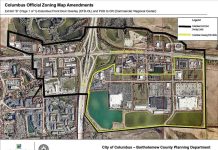
Atterbury-Bakalar Air Museum volunteers continue to make progress restoring a C-119 “Flying Boxcar” aircraft the museum purchased last year.
The 40,000-pound plane, which is not airworthy, was taken apart several months ago at an airport in Greybull, Wyoming, where the aircraft’s parts were loaded on to trucks and driven 1,460 miles to the Columbus Municipal Airport.
The final pieces of the aircraft arrived in July.
Over the past few weeks, about 10 volunteers have been, among other things, cleaning the aircraft, replacing glass and finished painting some of the interior of the plane, which is in a hangar at the airport. Work will continue until the plane is ready to be moved just south of the McDonnell Douglas F-4 Phantom II aircraft now on display near the museum, said Skip Taylor, a museum member who is leading the C-119 project.
[sc:text-divider text-divider-title=”Story continues below gallery” ]
The volunteers are starting to make replacement panels for the plane, repairing doors and cleaning out and painting the interior belly of the aircraft so they can install flooring, Taylor said.
“It’s like building a house,” Taylor said. “It looks like a house pretty quickly, but then it takes a lot of time to get through all the detail and it’s the detail that we’re working on now.”
The volunteers hope to have the aircraft at its display site in December, though work will continue on the aircraft for some time, Taylor said. The outer wings, which are roughly 37-feet long and 13-feet wide at their largest point, cannot be installed until the plane is at its site due to space constraints.
“We’ll take (the outer wings) over on a truck and install those over there (at the display site),” Taylor said. “Interestingly enough, we can’t get it down Ray Boll Boulevard with the outer wings on it because it will run into too much stuff.”
The C-119, also known as the “Flying Boxcar” due to the unusual shape of its fuselage, was in service with the U.S. Air Force from 1947 to 1972 and was designed to carry cargo, personnel, litter patients and mechanized equipment. The aircraft was also used to drop cargo and troops using parachutes, according to the Strategic Air Command and Aerospace Museum.
The aircraft, when assembled, is about 86-feet long, has a 110-foot wingspan and is 27-feet tall at the tail. The Flying Boxcars were powered by two Wright R-3350 Duplex Cyclone radial engines, each with 3,500 horsepower, and could reach a maximum speed of 296 miles per hour.
The U.S. Air Force extensively used C-119s during the Korean War from 1950 to 1953. Retired C-119s were also used as air tankers to fight wildfires in the United States.
The particular C-119 purchased by the museum was built in Hagerstown, Maryland, for the Canadian Air Force, Taylor said. The aircraft was later acquired by Hawkins & Powers and used to fight forest fires. Its last known flight was in 1990.
The Flying Boxcars are of particular historical significance to Columbus, according to museum volunteers. Here, the pilots referred to them as the “Dollar Nineteens,” according to museum records.
From 1957 to 1969, 36 C-119s for the 434th Troop Carrier Wing were stationed at Bakalar Air Force Base, which is now Columbus Municipal Airport. The C-119s were a staple in Columbus, flown out of the base longer than any other aircraft.
Manufacturers Fairchild and Kaiser built 1,151 of the C-119s from 1949 to 1955. However, only around 40 Flying Boxcars are still left today, most of them in museums across the country or in a scrap yard.
The Atterbury-Bakalar Air Museum purchased the plane for $15,000 in May 2019.
[sc:pullout-title pullout-title=”Where to learn more” ][sc:pullout-text-begin]
Visit atterburybakalarairmuseum.org/project-charlie-119.html for more information about the project.
People interesting in volunteering for the project should contact the Atterbury-Bakalar Air Museum at 812-372-4356.
[sc:pullout-text-end]




